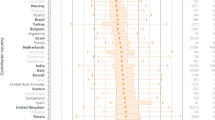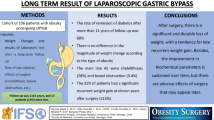Background: Bariatric surgery is the only currently available, effective, long-term method for controlling morbid obesity. Gastric banding as one of the possible surgical treatments was repeatedly described during the last 10 years. It is a reversible surgical procedure which is primarily performed laparoscopically. Methods: From 1993 to 1998 at the 1st Surgical Department Faculty General Hospital Charles University in Prague we performed nonadjustable gastric banding laparoscopically in 487 patients with morbid obesity (body mass index [BMI] 34 to 49 kg/m2). There were 429 females and 58 males in this group. Results: In 487 patients who underwent laparoscopic nonadjustable gastric banding (LNGB): early postoperative complications occurred in 29 cases (5.9%)--swelling of the gastric mucosa at the site of the nonadjustable band. In three cases (0.6%)--gastric perforations, and in two patients (0.4%)-- bleeding from gastric ulceration at the site of the band. Swelling was treated conservatively with a nasogastric tube and antisecretory and antiedematic drugs. Bleeding was treated by gastrofibroscopy and gastric perforation by open suture of the lesion. Late complications after LNGB occurred in eight patients (1.7%)--gastritis or esophagitis (but at the site of the band in only two patients [0.4%]), and in 13 patients (2.7%)--small upper pouch dilatation. In 24 cases (4.9%), we discovered slippage of the anterior stomach wall above the band. In three patients (0.6%), the band migrated through the gastric wall in 6-12 months following surgery. In the majority of cases, treatment of these complications was conservative. In eight patients we removed the band by laparoscopy, and in three patients we removed the migrating band from the stomach by open gastrotomy. Other complications have been treated conservatively by correcting the diet, prokinetic drugs, and antisecretory treatment. Conclusions: According to our long-term results, LNGB by experienced bariatric and laparoscopic surgeons is a viable method with low morbidity. In our 487 patients, there were major complications (necessitating reoperation) in 3.2% and minor complications (treated conservatively) in 10.4%.
Similar content being viewed by others
Author information
Authors and Affiliations
Rights and permissions
About this article
Cite this article
Kasalicky, M., Fried, M. & Peskova, M. Some Complications After Laparoscopic Nonadjustable Gastric Banding. OBES SURG 9, 443–445 (1999). https://doi.org/10.1381/096089299765552710
Published:
Issue Date:
DOI: https://doi.org/10.1381/096089299765552710




